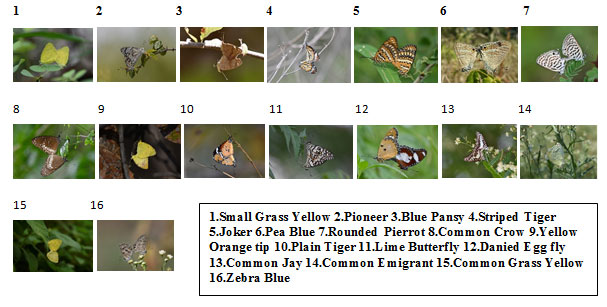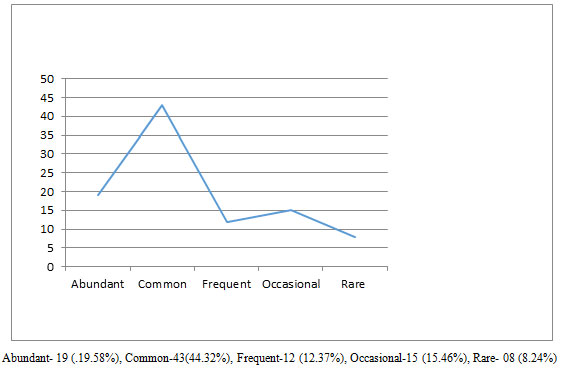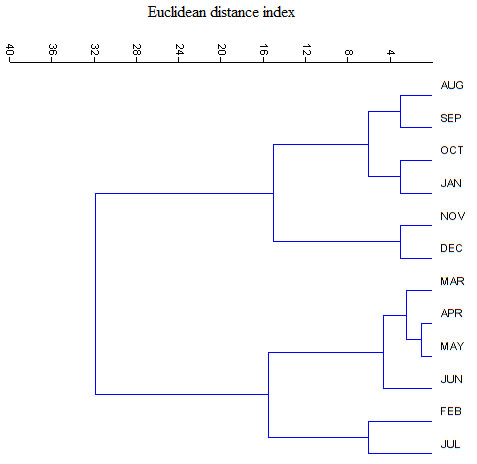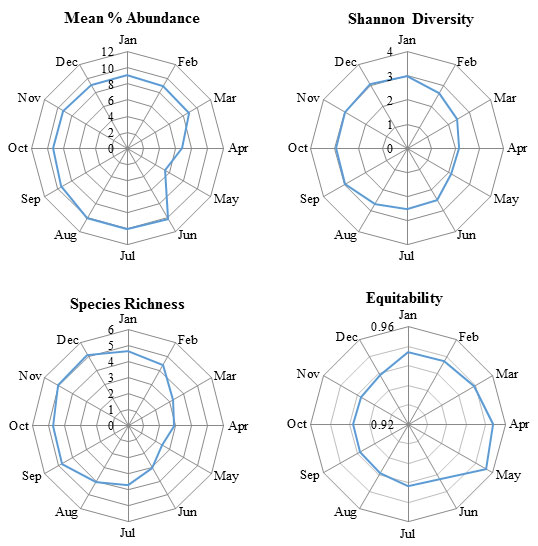Department of Zoology Shivramji Moghe Arts, Commerce and Science College,
Kelapur, Pandharkawada, Yavatmal, Maharashtra India
Corresponding author email: ramzan_virani@yahoo.co.in
Article Publishing History
Received: 10/07/2020
Accepted After Revision: 18/09/2020
Butterflies are considered as the best indicators of the health of any specified terrestrial ecosystem. They are key components in maintaining ecological dynamics of the protected areas and protected areas provides major support systems for maintaining their diversities. This scientific exercise is undertaken from 1 Dec. 2017 to 30 Nov. 2018 to explore butterfly diversity in Tipeshwar Wildlife Sanctuary, a protected area spread over 148.63 km² and located at 78º20’22’’ to 78º47’56’’ East and 19º50’59’’ to 19º55’44’’ North situated in the Deccan peninsular of Central Indian landscape. Varieties of plant species of this dry deciduous forest and seasonal variation in floral composition of this wildlife sanctuary attract verities of butterfly species.97 species of butterflies belong to 64 genera of 5 families dominated by family Nymphalidae (34.02%), Lycaenidae (27.83%) followed by Pieridae (19.59%), Hesperiidae (11.34%) and Papilionidae (7.21%) are recorded.It appears that the butterfly abundance increased from monsoon to winter while decreased in summer and pre-monsoon possibly due to the unavailability of nectar and the changes in temperature and humidity of this protected area. Butterflies are considered as an important model group in understanding ecology of a particular landscape. This research exercise will help in understanding ecology of this protected area and prove to be the important biological tool in devising the strategies for sustainable conservation of wildlife of this protected area and similar geographical regions.
Butterfly, Bioindicators, Diversity, Population dynamics, Tipeshwar
Virani R. S. Diversity of Butterflies in Tipeshwar Wildlife Sanctuary of Maharashtra, India. Biosc.Biotech.Res.Comm. 2020;13(3).
Virani R. S. Diversity of Butterflies in Tipeshwar Wildlife Sanctuary of Maharashtra, India. Biosc.Biotech.Res.Comm. 2020;13(3). Available from: https://bit.ly/31qZMcf
Copyright © Virani et al., This is an open access article distributed under the terms of the Creative Commons Attribution License (CC-BY) https://creativecommons.org/licenses/by/4.0/, which permits unrestricted use distribution and reproduction in any medium, provide the original author and source are credited.
INTRODUCTION
The butterflies are the most attractive elements of the biological diversity of the universe (Losey and Vaughan 2006). They are beautifully coloured, ecologically important insects belong to order Lepidoptera of class insecta. There are 1.5 million identified animal species harbour on the earth, class insecta alone contributes near about 0.8 million species whereas butterfly and moth shares 0.14 million species.More than 1700 species of butterflies are recorded from across the globe, of this India alone contributes 1504 (Gaonkar 1996; Smetacek 1992; Kunte 2009; Roy et al., 2010). Central India is home of 1400 species of butterfly (A Biodiversity Atlas- India Website ), 167 amongst them are reported from Vidarbha, (Triple 2011). 111 species of butterfly are reported in and around Tadoba National Park of central India (Tiple 2010). Diversity of butterflies in Karhandla region of Umred-Karhandla wildlife sanctuary, studied by Gajbe (2016) and 53 species of butterflies belong to 34 genera of 5 families are recorded inhabiting in this protected area. Butterflies show co-evolutionary relationship with the plants and perform prominent roles in pollination (Tiple et al 2006; Tiple 2018).
As pollinators butterflies are valuable creatures in maintaining the population dynamics of floral composition of natural and man-made ecosystems. Klein et al., (2008) have estimated that 35% of food use by human contributed from crop pollinated by insects (majorly by butterflies). As an integral part of prey-predator system they play major role in maintaining ecological balance in any type of ecosystem. As a bio-indicators, butterflies are useful in monitoring the ecological imbalance due to pollution, uncontrolled exploitation of natural resources, illegal encroachment and significant in studying the impact of rapid urbanisation on ecology in developing countries like India, (Khairunnisa et al., 2015). Global climate change has detrimental effect on butterfly diversity and its distribution as they are very specific in ecological requirements such as temperature, humidity, food plants and egg-laying habitats, (Forister and Shapiro 2003; Gonzalez-Megias et al., 2008).
Temperature and relative humidity are the important factors in distribution and assemblage of Butterfly species (Gupta et al., 2019). Butterflies are considered as the best indicators of the health of any specified terrestrial ecosystem (Thomas 2005; Bonebrake et al., 2010) and therefore treated as an important model group in understanding ecology of any landscape and to draw strategies for conservation accordingly (Watt and Boggs 2003; Ehrlich and Hanski 2004; Mukherjee et al., 2015). They are key components in maintaining ecological dynamics of the protected areas and protected areas are major support systems for maintaining their diversities. Distribution and variation in butterfly diversity changes in heterogeneous habitats with different ecological parameters (Suryanarayana et al., 2018).
This research exercise was aimed to estimate butterfly diversity in the Tipeshwar Wildlife Sanctuary, Maharashtra, India. Varieties of plant species of this dry deciduous forest and seasonal variation in floral composition of this wildlife sanctuary attract verities of species of butterfly. The results of this research exercise will help in understanding ecology of Tipeshwar Wildlife Sanctuary and it will prove to be the important biological tool in devising the strategies conservation of wildlife of this protected area and similar geographical regions by understanding ecological role of these flying beauties.
MATERIALS AND METHODS
Study area: The Tipeshwar Wildlife Sanctuary situated in Yavatmal District of Indian state Maharashtra. It is located between of 78º20’22’’ to 78º47’56’’ East and 19º50’59’’ to 19º55’44’’ North with total area of 148.63 sq. km. It constitutes compact patches of dense forest cover with meadows and a seasonal wetland. It has great utility from the point of view of wildlife and bio-diversity conservation. The main portion of this protected area constitutes the dry teak bearing forest. The climatic condition of this area is characterized by a hot summer, well-distributed rainfall during the south-west monsoon season and generally dry weather during rest of the year. The cold season is from December to February (Yavatmal Gazetteer 2019).
Survey method: The butterflies were observed from the study sites for a period of 1 year between 1 Dec. 2017 to 30 Nov. 2018. During the survey, an efficient protocol was adopted. The survey was made using a “Pollard Walk” method (Pollard 1977; Pollard and Yates 1993) with necessary modifications. Study area was visited twice a month from early morning (8:00 AM) to afternoon (11:00 AM) during good weather periods.
Species identification: After detection, a butterfly was photographed in field (Nikon D7100+ Nikkor 105 micro lense; Nikon Inc., Tokyo, Japan) and identified with the help of visible structural features. For identification and comparative studies of observed specimens, keys and methods suggested by Evans (1932), Wynter-Blyth (1957), Haribal (1992), Kunte (2000) and Kehimkar (2008) were adopted.
Data analysis : Species occurrence analysis was carried out by Microsoft excel program with using the following formulas. Relative Dominance (RD) of species was calculated as [RD=Ni × 100/Nt] where, Ni is number of individuals of species and Nt is total number of individuals all species (Basavarajappa 2006; Joshi 2014). Relative Occurrence (RO) of family was calculated as [RO= Ns × 100/Nt] where, Ns is number of species of each family and Nt is total number of all species (Basavarajappa 2006; Joshi 2014). Mean percent occurrence (M%) for month was calculated as [M% = Nm × 100 /Nt] where, Nm is number of individuals in each month and Nt is total number of individuals during complete study tenure (Basavarajappa 2006; Joshi and Tantarpale 2016). The mean values of the pooled species occurrence data were used to calculate the monthly diversity of and to categorize the local status of species.
The diversity assessment enabled highlighting the observed species richness pattern of the saurian species. The diversity indices were quantified with the help of PAST Version 1.60 software (Palaeontological Asso., Norway; Hammer et al., 2001). The species diversity was calculated using Shannon diversity index that calculated as [ ], where Pi is proportion of the first species which is given by Pi= ni/N (Magurran 1988); species richness was obtained by using Margalef equation [R= (S-1)/ log N], Where, R is Index of species richness, S is Total number of species and N is Total No. of individuals (Magurran 1988); while Species equitability was determined by equation of Pielou [J= N1/N0] where N1 is Number of abundant species in the sample and N0 is Number of species in the sample (Hammer et al., 2001).
The similarity association matrix upon which the cluster based was computed using the nearest neighbour pair linkage algorithm of Euclidean distance index for presence and absence data (Hammer et al., 2001). The differences between the diversity and evenness indices of with species occurrence among different study months were statistically analyzed by using Analysis of variance (ANOVA). The statistical analyses were performed following Zar (1999) using the SPSS version 10 (SPSS Inc., Chicago, Il, USA; Kinnear and Gray 2000).
RESULTS AND DISCUSSION
During this study, 97 butterfly species under five families were observed in study area (Table 1). Based on value of butterfly relative dominance in study area, 19.59 % species was categorized as abundant species whereas 44.32 % species was common, 12.37 % species was frequent, 15.46 % was occasional, and 8.24 % species was rare (Figure 1). The maximum number of butterfly species were recorded under family Nymphalidae (34.20 %), Lycaenidae (27.83 %) followed by Pieridae (19.58 %), Hesperiidae (11.34 %) and Papilionidae (7.21 %) (Figure 2).
A dendrogram developed by Euclidean distance cluster analysis was observed to be multifaceted and showed variation in the level of similarity in the number of butterfly species in 12 months. The months with the minimum to moderate number of species belong to one cluster, whereas the rest of the months with moderate to maximum number of species formed another cluster (Figure 3). It appears that the butterfly abundance increased from monsoon to winter while decreased in the summer and pre-monsoon possibly due to the unavailability of nectar and the change in temperature and humidity of the habitats concerned.
Observations on the monthly variations of butterfly abundances indicate patterns of peak from June to November while a low from December May and from (Figure 3). Mean percent abundance of butterflies was significantly different (F = 121.8, df = 11, p < 0.05); Shannon diversity values of butterflies were significantly different (F= 148.2, df = 11, p < 0.05); species evenness among different months was significantly different (F= 142.1, df = 11, p < 0.05) while species richness among the study months was significantly different (F = 156.4 df = 11, p < 0.05). A trend in mean % abundance, Shannon diversity, species richness and species equitability showed the contradictory patterns (Figure 4).
Table 1. Butterfly diversity in the Tipeshwar Wildlife Sanctuary, Maharashtra, India during 1 Dec. 2017 to 30 Nov. 2018
Breeding Records of some butterflies from 1 Dec. 2017 to 30 Nov. 2018 in Tipeshwar Wildlife Sanctuary
Figure 1: Relative occurrence of butterfly Species from 1 Dec. 2017 to 30 Nov. 2018 in Tipeshwar Wildlife Sanctuary
Figure 2: Relative dominance of butterfly families studied from 1 Dec. 2017 to 30 Nov. 2018 in the Tipeshwar Wildlife Sanctuary, Maharashtra, India
Figure 3: Dendrogram showing similarity in number of butterfly species composition among the studied month during 1 Dec. 2017 to 30 Nov. 2018
Figure 4: The values of the diversity indices in different months from 1 Dec. 2017 to 30 Nov. 2018 observed through the random sampling of butterflies in the Tipeshwar Wildlife Sanctuary, Maharashtra, India
The butterflies are the ecologically important organisms that serves as indicators of environmental conditions (Stefanescu et al., 2004). Observations on the butterfly diversity provide the information about variations in the species richness and the abundance in relation to the vegetation and associated landscapes (Öckinger and Smith 2006; Öckinger et al., 2006; Mutmainnah and Santosa 2019). In this context, the diversity of butterflies in the Tipeshwar Wildlife Sanctuary, Maharashtra, India was studied during Dec. 2017 to 30 Nov. 2018. Varieties of plant species of this dry deciduous forest and seasonal variation in floral composition of this protected area attract varieties of species of butterfly. The earlier studies showed that heterogeneity of the habitats in terms of the available plant species supports the rich butterfly diversity (Kuussaari et al., 2007; Mukherjee et al., 2015). Butterfly diversity even in the agricultural landscape contrast to the urban and suburban regions show that the richness increased with the availability of the green space and the heterogeneity of the habitats in terms of the available plant species (Öckinger et al., 2009; Mukherjee et al., 2015).
Consistent with these studies the present observation records a total of 97 species belonging to five families.It was observed that the family Nymphalidae represented by 18 genera and 33 species was the most dominant followed by Lycaenidae (23 genera, 27 species), Pieridae (10 genera, 19 species), Hesperiidae (10 genera, 11 species), and Papilionidae (3 genera, 7 species). The maximum number of butterfly species was recorded under family Nymphalidae and Lycaenidae followed by Pieridae, Hesperiidae and Papilionidae. Relative dominance of butterfly species studied is, 19.58 % species was categorized as abundant whereas 44.32 % species as common, 12.37 % species as frequent, 15.46 % as occasional, and 8.24 % species was rare.
Out of these 97 butterfly species studied, 15 species specified under Indian Wildlife (Protection) Act, 1972 were encountered in good numbers. The butterflies Pachliopta hector Castalius rosimon and Virachola isocrates are placed in Schedule I Part IV, the species Appias albino, Cepora nerissa, Hypolimnas misippus, Polyura athamas, Charaxes bernardus, Anthene lycaenina, Charaxes solon, Euchrysops cnejus, Lampides boeticus. Prosotas dubiosa and Tajuria cippus are protected under Schedule II Part II, while Baoris farri is categorized as Schedule IV. It is observed that the species diversity and its abundance is high from monsoon to early winter and decline from early summer onwards due to the reduction in moisture and scarcity of host plant species. Temperature and relative humidity are the important factors in distribution and assemblage of Butterfly species (Gupta et al., 2019).
Observations on the monthly variations of butterfly encounters indicates that population is high in monsoon months and declining towards summer while diversity is at peak from August to December while a low from January to May. The present observations remain consistent with the records and views of the butterfly species in different parts of the world (Wilson et al., 2004; Tiple et al., 2006; Sodhi et al., 2010; Tiple 2018). The butterfly species observed in the present study remained similar to the available observations on the species in different parts of India bearing similar landscape patterns (Roy et al., 2012; Harsh 2014; Saikia 2014; Mukherjee et al., 2015). Dominance of the butterflies of the family Nymphalidae as revealed through the present study is similar to that observed in other parts of the country (Mutmainnah and Santosa 2019).
In parity with the species diversity observed in Tipeshwar Wildlife Sanctuary, Maharashtra, India, it may be assumed that the butterflies play diverse functional roles for the sustenance of the ecosystems. The richness in species composition in study area was also prominent in present investigation. The availability of the vegetation, seasonal wetland and allied factors render stability to the butterfly population and assemblages in the landscapes are possibly important contributors to the observed variations in the butterfly species. The present diversity study is confined to a limited area and selected habitats. There is, in the future, a chance of more species being reported because of few pockets and habitats in the studied area requiring more extensive exploration.
ACKNOWLEDGMENTS
Author is thankful to Dr. Ravikiran Govekar, Field Director, Pench Tiger Project; Mr. Pramod Panchbhai, DFO, Wildlife Division, Pandharkawada; Mr. Sandeep Chavhan ACF, Mr. Amar Sidam, RFO and field staff of Tipeshwar Wildlife Sanctuary for giving permission and providing needed facilities for this research. Special Acknowledgment to Mr. Bapurao, Mr. Boppa and Mr.Irfan for their help and support during conduct of this study.
REFERENCES
A Biodiversity Atlas- India Website, www.ifoundbutterflies.org
Basavarajappa S. (2006) Avifauna of agro-ecosystem of Maidan area of Karnataka. Zoo’s Print Journal 21:2217-2219.
Bonebrake TC, Ponisio C, Boggs CL, et al., (2010) More than just indicators: a review of tropical butterfly ecologyand conservation. Biological Conservation 143:1831-1841.
Das SK , Sahu HK. (2011) Preliminary Study on Butterflies of Sunabeda Wildlife Sanctuary: a Checklist with Three New Records for Orissa, India. The Indian Forester 137/10
D’Abreau, EA. (1931).The Central Provinces Butterfly List. Records of the Nagpur Museum Number VII. Government Printing Press, Nagpur City, p.1-39
Ehrlich PR, Hanski I. (2004) On the wings of checkerspots: a model system for population biology. Oxford: Oxford University Press. P. 408.
ENVIS Centre on Wildlife & Protected Areas,Hosted by Wildlife Institute of India, Dehradun, (http://wiienvis.nic.in/Database/ScheduleSpeciesDatabase_7969.aspx)
Evans WH. (1932) The identification of Indian butterflies. Bombay: Bombay Natural History Society. p. 464.
Forister ML and Shapiro, AM. (2003) Climatic trends and advancing spring flight of butterflies in lowland California. Global Change Biology, 9: 1130–1135.
Gaonkar H. (1996) Butterflies of Western Ghats with notes on those of Sri Lanka. A report to the Center of Ecological Sciences, Indian Institute of Science, Bangalore, Zoological Museum, Copenhagen and Natural History Museum,London, p.89
Gajbe PU.(2016) Diversity of Butterflies in Karhandla Region of Umred-Karhandla Wildlife Sanctuary, Maharashtra, India, Journal on New Biological Reports JNBR 5(1): 35 – 40
González-Megías A, Menéndez R, Roy D, Brereton T, Thomas CD, (2008) Changes in the composition of British butterfly assemblages over two decades. Global Change Biology, 14:1464–1474.
Gupta H., Tiwari C. and Diwakar S. (2019) Butterfly diversity and effect of temperature and humidity gradients on butterfly assemblages in a sub-tropical urban landscape. Tropical Ecology 60:150-158
Hammer Ø, Harper DAT, Ryan PD. 2001. Paleontological statistics software package for education and data analysis. Paleontologia Electronica 4:1-9.
Haribal M. 1992. The butterflies of Sikkim Himalayas and their natural history. Gangtok: Sikkim Nature Conservation Foundation (SNCF). p. 217.
Harsh S. 2014. Butterfly diversity of Indian institute of forest management, Bhopal, Madhya Pradesh, India. Journal of Insects 2014:1-4.
Joshi PS, Tantarpale VT. 2016. Diversity of Saurian fauna in the Buldhana district, Maharashtra, India. Journal of Asia-Pacific Biodiversity 9: 306-311
Joshi PS. 2014. Diversity and population dynamics of ophidian fauna from Buldhana District, Maharashtra, India. A thesis submitted to S.G.B. Amravati (India): Amravati University. pp. 1-260.
Kasambe R. (2016) Maharashtratil Fulpakhare, Sahitya Prasar Kendra, Nagpur. 2016.
Kehimkar I. 2008. The book of Indian butterflies. Mumbai: Bombay Natural History Society and Oxford University Press. p. 497.
Khairunnisa S, Sing KW, and Wilson JJ. (2015) Comparison of butterflies, bats and beetles as bioindicators based on four key criterion and DNA barcodes, Tropical Conservation Science Vol 8 (1): 138-149 (2015).
Khyade VB and Jagtap SG. (2017) Butterflies – Diversity in Mayureshwar Wildlife Sanctuary of Baramati Tehsil in Pune district (India), Journal of Entomology and Zoology Studies 2017; 5(2): 443-4573
Kinnear PR, Gray CD. (2000) SPSS for windows made simple. Release 10. Sussex. UK: Psychology Press. p. 432.
Koh LP, Sodhi NS. (2004) Importance of reserves, fragments, and parks for butterfly conservation in a tropical urban landscape. Ecological Applications 14:1695-1708.
Kunte K. (2000) Butterflies of Peninsular India. Hyderabad: Universities Press (India) Limited. p. 254.
Kuussaari M, Heliölä J, Luoto M, Pöyry J. (2007) Determinants of local species richness of diurnal Lepidoptera in boreal agricultural landscapes. Agriculture, Ecosystems and Environment 122:366-376.
Losey JE, Vaughan M. (2006) The economic value of ecological services provided by insects. BioScience 56:311-323.
Magurran AE. (1988) Ecological diversity and its measurement. London: Chapman and Hall. p. 192.
Mukherjee S, Banerjee S, Saha G, Basu P, Aditya G. (2015) Butterfly diversity in Kolkata, India: An appraisal for conservation management. Journal of Asia-Pacific Biodiversity 8: 210-221.
Mutmainnah AR, Santosa Y. (2019) Impact of oil palm plantation on the butterfly diversity: a Case study in KGP & CNG, Ketapang, West Kalimantan. IOP Conf. Series: Earth and Environmental Science 336: 012032.
Nimbalkar RK, Chandekar SK, Khunte SP. (2011) Butterfly diversity in relation to nectar food plants from Bhor Tahsil, Pune District, Maharashtra, India. Journal of Threatened Taxa 3:1601-1609.
Öckinger E, Dannestam Å, Smith HG. (2009) The importance of fragmentation and habitat quality of urban grasslands for butterfly diversity. Landscape and Urban Planning 93:31-37.
Öckinger E, Eriksson AK, Smith HG. (2006) Effects of grassland management, abandonment and restoration on butterflies and vascular plants. Biological Conservation 133:291-300.
Öckinger E, Smith HG. (2006) Landscape composition and habitat area affect butterfly species richness. Oecologia 149:526-534.
Pollard E, Yates TJ. (1993) Monitoring butterflies for ecology and conservation. London: Chapman and Hall. p. 292.
Pollard E. (1977) A method for assessing changes in the abundance of butterflies. Biological Conservation 12:115-134.
Roy, AB, Ghosh U, Kunte K, ( 2010) Sighting of Elymnias panther (Lepidoptera: Nymphalidae : Satyrinae) in West Bengal, eastern India. Journal of Threatened Taxa 2(1):670-671.
Roy US, Mukherjee M, Mukhopadhyay SK. 2012. Butterfly diversity and abundance with reference to habitat heterogeneity in and around Neora Valley National Park, West Bengal, India. Our Nature 10:53-60.
Smetacek, P. (1992). Record of Plebejus eversmanni (Stgr.)from India. Journal of the Bombay Natural History Society 89: 385-386
Saikia MK. 2014. Diversity of tropical butterflies in urban altered forest at Gauhati University Campus, Jalukbari, Assam. Journal of Global Biosciences 3:452-463.
Sodhi NS, Koh LP, Clements R, et al. 2010. Conserving Southeast Asian forest biodiversity in human-modified landscapes. Biological Conservation 143:2375-2384.
Stefanescu C, Herrando S, Páramo F. 2004. Butterfly species richness in the northwest Mediterranean Basin: the role of natural and human-induced factors. Journal of Biogeography 31:905-915.
Suryanarayana K, Reddy V, Sreekanth B, Nagalakshmi P and Venkataramana SP. (2018)
Butterfly diversity (Lepidoptera: Rhopalocera ) from three roadside sites at different elevations of Seshachalam, Nallamala Hills-Eastern ghat- Andhra Pradesh-India, International Journal of Current Research in Life Sciences Vol. 07, No. 04 :1789-1793
Thomas JA. (2005) Monitoring change in the abundance and distribution of insects using butterflies and other indicator groups. Philosophical Transactions of the Royal Society B 360:339-357.
Tiple AD, Deshmukh VP, Dennis RLH. (2006) Factors influencing nectar plant resource visits by butterflies on a university campus: implications for conservation. Nota Lepidopteralogica 28:213-224.
Tiple AD. ( 2010) Butterfly fauna in an around Tadoba National Park of Central India, Hislopia Journal 3 (1) 2010.
Tiple AD. (2011) Butterflies of Vidarbha region, Maharashtra State, Central India., Journal of Treatened Taxa, January 2011, 3(1): 1466-1474.
Tiple AD. (2018) Butterflies (Lepidoptera Rhopalocera) of the Bor wildlife sanctuary, Wardha, Maharashtra, Central India. Biodiversity Journal 9: 171-180.
Watt WB, Boggs CL. (2003) Synthesis: butterflies as model systems in ecology and evolution present and future. In: Boggs CL, Watt WB, Ehrlich PR, editors. Butterflies: ecology and evolution taking flight. Chicago: The University of Chicago Press. pp. 603e613.
Wilson EO. (1997) Introduction. In: Reaka-Kudla ML, Wilson DE, Wilson EO, editors. Biodiversity II. Washington, D.C: Henry Press. pp. 1-3.
Wilson RJ, Thomas CD, Fox R, et al. (2004) Spatial patterns in species distributions reveal biodiversity change. Nature 432:393-396.
Wynter-Blyth MA. (1957) Butterflies of the Indian region. Mumbai: Bombay Natural History Society. 523 p.
Yavatmal Gazetteer. (2019) Database of Buldhana District redirected from official website of Buldhana District, Maharashtra, India. Available at: www.yavtmal.nic.in [Date accessed: 01 January 2019].
Zar JH. (1999) Biostatistical analysis. 4th ed. New Delhi (Indian Branch): Pearson Education (Singapore) Pte. Ltd.. p. 667.








